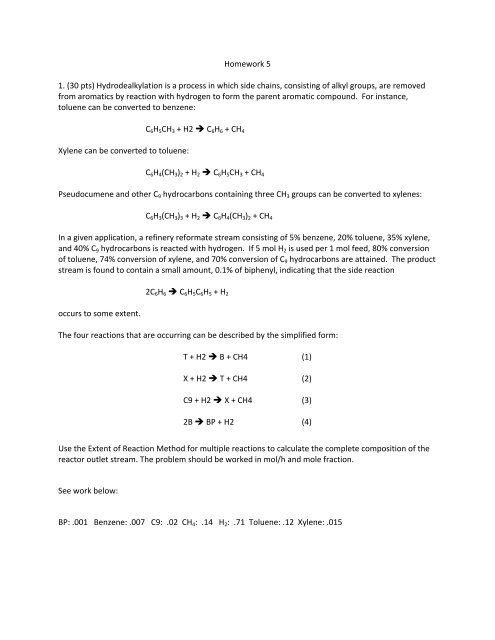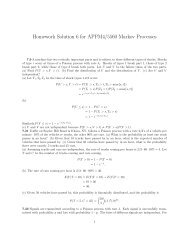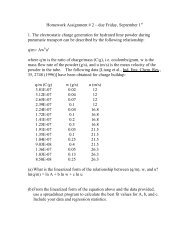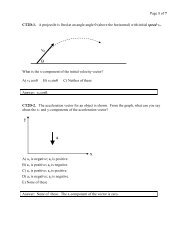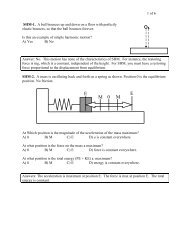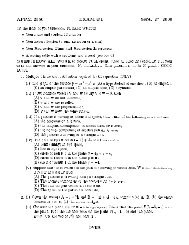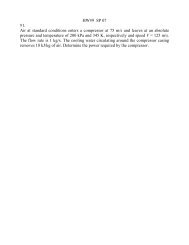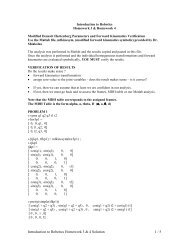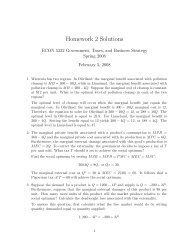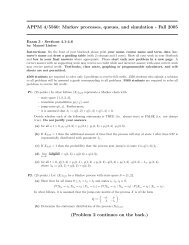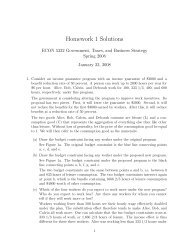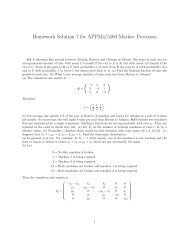Hydrodealkylation is a process in which side chains ... - cribME!
Hydrodealkylation is a process in which side chains ... - cribME!
Hydrodealkylation is a process in which side chains ... - cribME!
You also want an ePaper? Increase the reach of your titles
YUMPU automatically turns print PDFs into web optimized ePapers that Google loves.
Homework 51. (30 pts) <strong>Hydrodealkylation</strong> <strong>is</strong> a <strong>process</strong> <strong>in</strong> <strong>which</strong> <strong>side</strong> cha<strong>in</strong>s, cons<strong>is</strong>t<strong>in</strong>g of alkyl groups, are removedfrom aromatics by reaction with hydrogen to form the parent aromatic compound. For <strong>in</strong>stance,toluene can be converted to benzene:Xylene can be converted to toluene:C 6 H 5 CH 3 + H2 C 6 H 6 + CH 4C 6 H 4 (CH 3 ) 2 + H 2 C 6 H 5 CH 3 + CH 4Pseudocumene and other C 9 hydrocarbons conta<strong>in</strong><strong>in</strong>g three CH 3 groups can be converted to xylenes:C 6 H 3 (CH 3 ) 3 + H 2 C 6 H 4 (CH 3 ) 2 + CH 4In a given application, a ref<strong>in</strong>ery reformate stream cons<strong>is</strong>t<strong>in</strong>g of 5% benzene, 20% toluene, 35% xylene,and 40% C 9 hydrocarbons <strong>is</strong> reacted with hydrogen. If 5 mol H 2 <strong>is</strong> used per 1 mol feed, 80% conversionof toluene, 74% conversion of xylene, and 70% conversion of C 9 hydrocarbons are atta<strong>in</strong>ed. The productstream <strong>is</strong> found to conta<strong>in</strong> a small amount, 0.1% of biphenyl, <strong>in</strong>dicat<strong>in</strong>g that the <strong>side</strong> reaction2C 6 H 6 C 6 H 5 C 6 H 5 + H 2occurs to some extent.The four reactions that are occurr<strong>in</strong>g can be described by the simplified form:T + H2 B + CH4 (1)X + H2 T + CH4 (2)C9 + H2 X + CH4 (3)2B BP + H2 (4)Use the Extent of Reaction Method for multiple reactions to calculate the complete composition of thereactor outlet stream. The problem should be worked <strong>in</strong> mol/h and mole fraction.See work below:BP: .001 Benzene: .007 C9: .02 CH 4 : .14 H 2 : .71 Toluene: .12 Xylene: .015
Given .740 − nc940.7435 − nx35nB 5 − 2⋅squig4+ squig1 nH 500 − squig1− squig2 − squig3 + squig4nT 20 − squig1+ squig2nCH4 squig1 + squig2 + squig3nx 35 − squig2 + squig3 nc9 40 − squig3 nbp squig473.724 nBntot nbp + nx + nT + nH + nCH4 + c9 + nB .00112.000 nC99.100 nXnbpntotxnxntot.820 − nT20TnTnHHntotntot348.788 nH24.000 nT151.800 nCH40.588 nBP588.020 ntotal69.900 ζ153.900 ζ228.000 ζ30.588 ζ40.015 x xylenex0.007 toluene0.593 x H20.258 x CH40.020 x C9x0.125 benzene0.001 x BPCH4nCH4ntotc9nc9ntotBnBntotbpnbpntot
2. (30 pts) Methanol <strong>is</strong> produced by react<strong>in</strong>g carbon monoxide and hydrogen. A fresh feed conta<strong>in</strong><strong>in</strong>gCO and H 2 jo<strong>in</strong>s a recycle stream and the comb<strong>in</strong>ed stream <strong>is</strong> fed to the reactor. The reactor outletstream flows at a rate of 250 mole/m<strong>in</strong> and conta<strong>in</strong>s 63.1 mole % H 2 , 27.4 mole % CO and 9.53 % CH 3 OH.Th<strong>is</strong> stream enters a cooler <strong>in</strong> <strong>which</strong> most of the methanol <strong>is</strong> condensed. The liquid methanol <strong>is</strong>withdrawn as a product, and the gas stream leav<strong>in</strong>g the condenser, conta<strong>in</strong><strong>in</strong>g all three species with a0.40 mole % methanol vapor <strong>is</strong> the recycle stream that comb<strong>in</strong>es with the fresh feed.a) Draw a picture and label all of your knowns and unknowns.b) Do a degree of freedom analys<strong>is</strong> for the overall <strong>process</strong> and the condenser.c) F<strong>in</strong>d the molar flow rates of CO and H 2 <strong>in</strong> the fresh feed, the production of liquid methanol, and thes<strong>in</strong>gle‐pass and overall conversions of CO.H 2CH 3 OHGiven.0953250 ⋅ n3 + .004⋅n4250 n3 + n4 n1 n32n2 ⋅4n3 ⋅ .274⋅250xn4 ⋅F<strong>in</strong>d( n1, n2, n3, n4,x)→⎛⎜⎜⎜⎜⎜⎝22.91666666666666666745.83333333333333333322.916666666666666667227.08333333333333333.30165137614678899083⎞⎟⎟⎟⎠c) CO = 22.9 moles; H 2 =45.8 moles; production rate of methanol = 22.9 moles;s<strong>in</strong>gle pass: (22.9+.3*227.8)‐.274*250 = 25 %(22.9+.3*227.8)Overall: 100 %
3. (20 pts) In the Deacon <strong>process</strong> for the manufacture of chlor<strong>in</strong>e, HCl and O 2 react to form Cl 2 and H 2 0.Sufficient air (79 % N 2 and 21 % O 2 ) <strong>is</strong> fed to provide 35 % excess oxygen and the fractional conversion ofHCl <strong>is</strong> 85 %. Calculate the mole fractions of the product stream components us<strong>in</strong>g atomic speciesbalances.4HCl + O 2 → 2Cl 2 + 2H 2 OAssume 100 moles of HCl.1.35*100 moles HCl*(1 mole O 2 /4 moles HCl) = 33.75 moles O 2 com<strong>in</strong>g <strong>in</strong>Givennn2 33.75⋅ 3.76 .85100 − nhcl100100 2⋅ncl2+ nhcl 100 2⋅nh2o+ nhcl2⋅33.75nh2o + 2⋅no2ntot nn2 + nhcl + ncl2 + no2 + nh2on2nn2ntoto2no2ntothclnhclntotcl2ncl2ntoth2onh2ontotF<strong>in</strong>d( nn2, nhcl, ncl2, nh2o , no2, ntot , n2, o2, hcl, cl2,h2o)→N 2 = .53 O 2 = .052 HCl = .063 Cl 2 = .1775 H 2 O = .1775⎛⎜⎜⎜⎜⎜⎜⎜⎜⎜⎜⎜⎜⎜⎝126.9000000000000000015.⎟42.500000000000000000⎟⎟12.500000000000000000⎟239.40000000000000000⎟.53007518796992481203⎟⎟.52213868003341687552e-1⎟.62656641604010025063e-1 ⎟.17752715121136173768⎟.17752715121136173768⎞⎠
4. (20 pts) A mixture of NH 3 and air (21% O 2 , 79% N 2 ) <strong>is</strong> fed to a reactor at rates of 2000 mol/h air and100 mol/h NH 3 where they are reacted to produce a mixture of gases compr<strong>is</strong><strong>in</strong>g 3 mol% O 2 , 6 mol %NO, and the rest N 2 , NH 3 , H 2 O, and NO 2 . If the fractional conversion of NH 3 <strong>is</strong> f NH3 = 0.8, calculate theoutlet molar flow rate (mol/h) of each species. Do a degree of freedom analys<strong>is</strong> first! The follow<strong>in</strong>greactions are occurr<strong>in</strong>g:4NH 3 + 5O 2 4NO + 6H 2 O4NH 3 + 3O2 2N 2 + 6H 2 O2NO + O 2 2NO 2Given.8100 − nnh3100.79⋅ 2⋅2000+ 100 nnh3 + nno + nno2 + nn2⋅2300 3nnh3 + 2nh2o.21⋅ 2⋅20002⋅no2+ 2⋅nno+ nh2o + 2nno2ntot nnh3 + no2 + nno + nh2o + nn2 + nno21969.543 total20.000 NH359.086 O2118.173 NO120.000 H2O1469.543 N2182.741 NO2


